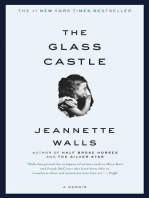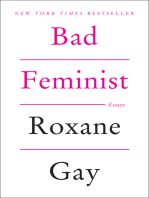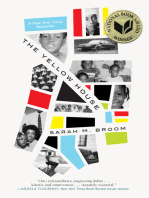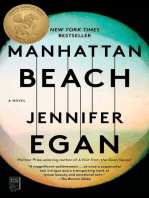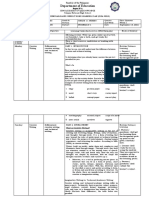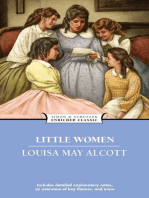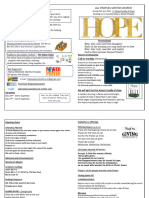0 ratings0% found this document useful (0 votes)
CW Long Test
CW Long Test
Uploaded by
anjelyka BThis document contains two sets (A and B) of multiple choice and matching questions that test identification of literary devices such as metaphor, simile, personification, and idioms. It also contains exercises for identifying examples of figurative language in short phrases and writing a short poem using imagery and literary devices. The questions cover topics like sensory imagery, figurative language, sound devices, and identifying examples of techniques such as metaphor, pun, and personification.
Copyright:
© All Rights Reserved
Available Formats
Download as DOCX, PDF, TXT or read online from Scribd
Download as docx, pdf, or txt
CW Long Test
CW Long Test
Uploaded by
anjelyka B0 ratings0% found this document useful (0 votes)
This document contains two sets (A and B) of multiple choice and matching questions that test identification of literary devices such as metaphor, simile, personification, and idioms. It also contains exercises for identifying examples of figurative language in short phrases and writing a short poem using imagery and literary devices. The questions cover topics like sensory imagery, figurative language, sound devices, and identifying examples of techniques such as metaphor, pun, and personification.
Original Title
cw long test
Copyright
© © All Rights Reserved
Available Formats
DOCX, PDF, TXT or read online from Scribd
Share this document
Did you find this document useful?
Is this content inappropriate?
This document contains two sets (A and B) of multiple choice and matching questions that test identification of literary devices such as metaphor, simile, personification, and idioms. It also contains exercises for identifying examples of figurative language in short phrases and writing a short poem using imagery and literary devices. The questions cover topics like sensory imagery, figurative language, sound devices, and identifying examples of techniques such as metaphor, pun, and personification.
Copyright:
© All Rights Reserved
Available Formats
Download as DOCX, PDF, TXT or read online from Scribd
Download as docx, pdf, or txt
0 ratings0% found this document useful (0 votes)
CW Long Test
CW Long Test
Uploaded by
anjelyka BThis document contains two sets (A and B) of multiple choice and matching questions that test identification of literary devices such as metaphor, simile, personification, and idioms. It also contains exercises for identifying examples of figurative language in short phrases and writing a short poem using imagery and literary devices. The questions cover topics like sensory imagery, figurative language, sound devices, and identifying examples of techniques such as metaphor, pun, and personification.
Copyright:
© All Rights Reserved
Available Formats
Download as DOCX, PDF, TXT or read online from Scribd
Download as docx, pdf, or txt
You are on page 1/ 2
SET A SET B
LONG TEST IN CREATIVE WRITING LONG TEST IN CREATIVE WRITING
A. Identifying Terms A. Identifying Terms
Write the word being described in each number. Write the word being described in each number.
1. This kind of imagery appeals to the sense of sight 1. It pertains to the feeling of movement.
like shape, color, appearance, shade and others. 2. This kind of imagery appeals to the sense of sight
2. It is a type of sensory imagery that appeals to the like shape, color, appearance, shade and others.
sense of smell. 3. This pertains to the sense of hearing.
3. This Engages the sense of touch that includes 4. It is a type of sensory imagery that appeals to the
textures and the many sensations a human being sense of smell.
experiences when touching. 5. This Engages the sense of touch that includes
4. It pertains to the feeling of movement. textures and the many sensations a human being
5. This pertains to the sense of hearing. experiences when touching.
B. Multiple Choice B. Multiple Choice
Choose the letter of the best answer. Choose the letter of the best answer.
6. It projects human qualities onto inanimate objects, 6. The statement, “ Her mother needs to feed six
or perhaps animals or natural elements. mouths everyday.” Is an example of
a. metaphor c. personification A. metaphor c. personification
b. pun d. synecdoche B. pun d. synecdoche
7. This is a figurative language that plays on words 7. This is a figurative language that plays on words
and exploits the different meaning of a word or its and exploits the different meaning of a word or its
homonyms, usually to humorous effect. homonyms, usually to humorous effect.
a. metaphor c. personification A. metaphor c. personification
b. pun d. synecdoche B. pun d. synecdoche
8. It is a sound device that layers some additional 8. It projects human qualities onto inanimate objects,
meaning on top of the literal language of the text. or perhaps animals or natural elements.
It occurs when a series of sound start with the c. metaphor c. personification
same letter sound. d. pun d. synecdoche
a. alliteration c. assonance 9. It is a sound device that layers some additional
b. hyperbole d. personification meaning on top of the literal language of the text.
9. The figurative language that are oftentimes used It occurs when a series of sound start with the
to create auditory imageries in writing. same letter sound.
a. alliteration and onomatopoeia A. alliteration c. assonance
b. idiom and pun B. hyperbole d. personification
c. apostrophe and allusion 10. The figurative language that are oftentimes used
d. personification and metaphor to create auditory imageries in writing.
10. The statement, “ Her mother needs to feed six A. alliteration and onomatopoeia
mouths everyday.” Is an example of B. idiom and pun
a. metaphor c. personification C. apostrophe and allusion
b. pun d. synecdoche D. personification and metaphor
C. Identifying Figurative Language C. Identifying Figurative Language
11. My heart goes out of my chest whenever I see him. 11. Music is the artist’s bread and butter.
12. I was struggling to figure out how lightning works, 12. Love, who needs you?
but then it struck me. 13. Is there an Einstein in your Physics class?
13. He hit the nail on the head after delivering his 14. He hit the nail on the head after delivering his
opinion about the issue. opinion about the issue.
14. Music is the artist’s bread and butter. 15. New York is a city that never sleeps.
15. New York is a city that never sleeps. 16. Chicago is a city that is as fierce as a dog with
16. Chicago is a city that is as fierce as a dog with tongue lapping for action.
tongue lapping for action. 17. My heart goes out of my chest whenever I see him.
17. Is there an Einstein in your Physics class? 18. I was struggling to figure out how lightning works,
18. All Adam ate in August was apples and almonds. but then it struck me.
19. Try as I might, the kite did not fly. 19. All Adam ate in August was apples and almonds.
20. Love, who needs you? 20. Try as I might, the kite did not fly.
D. Writing a Poem (10pts.) D. Writing a Poem (10 pts.)
Create a one stanza poem that makes use of at Create a one stanza poem that makes use of at
least two types of figurative language and imagery. least two types of figurative language and imagery.
WRITTEN WORK #3 WRITTEN WORK #3
You might also like
- The Subtle Art of Not Giving a F*ck: A Counterintuitive Approach to Living a Good LifeFrom EverandThe Subtle Art of Not Giving a F*ck: A Counterintuitive Approach to Living a Good Life4/5 (6052)
- The Gifts of Imperfection: Let Go of Who You Think You're Supposed to Be and Embrace Who You AreFrom EverandThe Gifts of Imperfection: Let Go of Who You Think You're Supposed to Be and Embrace Who You Are4/5 (1142)
- Never Split the Difference: Negotiating As If Your Life Depended On ItFrom EverandNever Split the Difference: Negotiating As If Your Life Depended On It4.5/5 (916)
- Hidden Figures: The American Dream and the Untold Story of the Black Women Mathematicians Who Helped Win the Space RaceFrom EverandHidden Figures: The American Dream and the Untold Story of the Black Women Mathematicians Who Helped Win the Space Race4/5 (946)
- The Hard Thing About Hard Things: Building a Business When There Are No Easy AnswersFrom EverandThe Hard Thing About Hard Things: Building a Business When There Are No Easy Answers4.5/5 (360)
- Devil in the Grove: Thurgood Marshall, the Groveland Boys, and the Dawn of a New AmericaFrom EverandDevil in the Grove: Thurgood Marshall, the Groveland Boys, and the Dawn of a New America4.5/5 (273)
- The World Is Flat 3.0: A Brief History of the Twenty-first CenturyFrom EverandThe World Is Flat 3.0: A Brief History of the Twenty-first Century3.5/5 (2283)
- A Heartbreaking Work Of Staggering Genius: A Memoir Based on a True StoryFrom EverandA Heartbreaking Work Of Staggering Genius: A Memoir Based on a True Story3.5/5 (233)
- LAC Session 4 Understanding Learners' Mulitiple Intelligences 2No ratings yetLAC Session 4 Understanding Learners' Mulitiple Intelligences 23 pages
- Path Planning Optimization Using ADAMS and HEEDSNo ratings yetPath Planning Optimization Using ADAMS and HEEDS25 pages
- Maltparser: A Language-Independent System For Data-Driven Dependency ParsingNo ratings yetMaltparser: A Language-Independent System For Data-Driven Dependency Parsing42 pages
- Sathya Sai Balavikas (Telugu Monthly Magazine) May 2012No ratings yetSathya Sai Balavikas (Telugu Monthly Magazine) May 201224 pages
- Objectives in This Lesson, You Will Learn To: Connect To A Database by Creating A Data AdapterNo ratings yetObjectives in This Lesson, You Will Learn To: Connect To A Database by Creating A Data Adapter14 pages
- Ai System To Assist Legal Processes Using Natural Language ProcessingNo ratings yetAi System To Assist Legal Processes Using Natural Language Processing32 pages
- تهمة الاعتزال في تفسير ابن عطية الأندلسيNo ratings yetتهمة الاعتزال في تفسير ابن عطية الأندلسي22 pages
- Metasys For Validated Environments On Site Management Portal Catalog PageNo ratings yetMetasys For Validated Environments On Site Management Portal Catalog Page6 pages
- Veritas Netbackup™ Self Service Release NotesNo ratings yetVeritas Netbackup™ Self Service Release Notes10 pages
- TMCL Reference and Programming Manual: Trinamic Motion Control GMBH & Co. KG Sternstraße 67 D - 20357 Hamburg, GermanyNo ratings yetTMCL Reference and Programming Manual: Trinamic Motion Control GMBH & Co. KG Sternstraße 67 D - 20357 Hamburg, Germany86 pages
- Inquiry Learning Collaborative PlanningNo ratings yetInquiry Learning Collaborative Planning14 pages
- Indian Institute of Technology, Madras - Centre For Continuing EducationNo ratings yetIndian Institute of Technology, Madras - Centre For Continuing Education211 pages
- Allied-III - American History and LiteratureNo ratings yetAllied-III - American History and Literature5 pages
- AN 132 Re-Assigning COM Port Numbers Using RegistryNo ratings yetAN 132 Re-Assigning COM Port Numbers Using Registry17 pages




